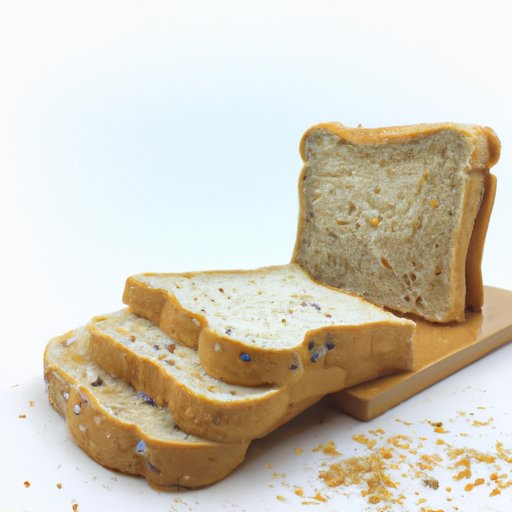Introduction
Whole wheat bread has become one of the most popular choices for those looking to lead a healthier lifestyle. But is it actually good for you? In this article, we’ll explore the nutritional value of whole wheat bread and the health benefits of including it in your diet. We’ll also look at the pros and cons of eating whole wheat bread, so you can make an informed decision about what’s best for your health.

Exploring the Health Benefits of Whole Wheat Bread
Whole wheat bread is high in fiber and complex carbohydrates, making it a great source of energy. It also contains important vitamins and minerals that are essential for good health. Here’s a closer look at the health benefits of eating whole wheat bread:
Nutritional Value
Whole wheat bread is a good source of protein, which helps to build and repair muscle. It’s also a good source of B vitamins, which are essential for healthy metabolism. Additionally, whole wheat bread is packed with minerals such as iron, magnesium, and zinc, which are all essential for good health.
Weight Loss Benefits
Eating whole wheat bread can help with weight loss. Studies have found that people who eat whole grains tend to have lower body mass index (BMI) than those who don’t eat whole grains. This is because whole wheat bread is low in calories and high in fiber, which helps to keep you feeling full longer and prevents overeating.
Healthier Digestive System
Whole wheat bread is also beneficial for your digestive system. The high fiber content helps to promote regularity, which can help to reduce the risk of constipation and other digestive issues. In addition, the vitamins and minerals in whole wheat bread can help to boost your immune system, keeping you healthy and energized.

Nutrition Facts: Examining the Nutritional Value of Whole Wheat Bread
Now let’s take a closer look at the nutrition facts of whole wheat bread. Here’s a breakdown of the nutrients found in a single slice of whole wheat bread:
Vitamins and Minerals
A single slice of whole wheat bread contains 6% of your daily value (DV) of thiamin, 4% DV of riboflavin, 8% DV of niacin, 10% DV of vitamin B6, and 2% DV of folate. It also contains 1% DV of calcium, 6% DV of magnesium, 4% DV of phosphorus, 5% DV of potassium, and 3% DV of zinc.
Calories, Carbs, and Fat Content
One slice of whole wheat bread contains 90 calories, 15 grams of carbohydrates, 1 gram of fat, and 4 grams of dietary fiber. It also contains 4 grams of protein.

A Look at the Pros and Cons of Eating Whole Wheat Bread
Before you decide to add whole wheat bread to your diet, it’s important to understand the advantages and disadvantages of doing so. Here’s a look at both sides:
Advantages
The biggest advantage of eating whole wheat bread is its nutritional value. As mentioned earlier, it’s a good source of vitamins and minerals, as well as protein, carbs, and fiber. Additionally, it may help with weight loss and keep your digestive system healthy.
Disadvantages
The main disadvantage of eating whole wheat bread is that it can be relatively high in calories and carbs. If you’re trying to lose weight, it’s important to watch your portion sizes and choose whole wheat bread with fewer calories and carbs. Additionally, some people may experience digestive issues when consuming large amounts of fiber from whole wheat bread.
Is Whole Wheat Bread Good for You?
Overall, whole wheat bread can be a healthy choice if eaten in moderation. It’s packed with essential vitamins and minerals, and it can help you maintain a healthy weight and digestive system. However, it’s important to remember that it can be high in calories and carbs, so it’s best to watch your portion sizes and opt for whole wheat bread with fewer calories and carbs.
Whole Grain Bread: The Better Choice for a Healthy Diet
If you’re looking for a healthier alternative to white bread, whole grain bread is the way to go. Whole grain bread is made from whole grains, which means it contains the entire grain kernel—including the bran, germ, and endosperm. This makes it higher in fiber and other essential nutrients than white bread.
Benefits of Whole Grain Bread
Whole grain bread is packed with fiber, which can help to keep you feeling full longer and prevent overeating. It’s also a good source of B vitamins, iron, magnesium, and zinc. Additionally, studies have found that people who eat whole grains tend to have lower BMI than those who don’t eat whole grains.
Making the Switch to Whole Grain Bread
Switching to whole grain bread is easy. Start by replacing white bread with whole grain bread and gradually increase the amount of whole grain bread you eat. You can also add whole grain bread to salads, sandwiches, and other meals for an extra boost of nutrition.
Conclusion
Whole wheat bread can be a healthy choice when eaten in moderation. It’s packed with essential vitamins and minerals, and it can help you maintain a healthy weight and digestive system. However, it’s important to remember that it can be high in calories and carbs, so it’s best to watch your portion sizes and opt for whole wheat bread with fewer calories and carbs. For a healthier alternative, try switching to whole grain bread. Whole grain bread is higher in fiber and other essential nutrients than white bread, and it can help to keep you feeling full longer and prevent overeating.
(Note: Is this article not meeting your expectations? Do you have knowledge or insights to share? Unlock new opportunities and expand your reach by joining our authors team. Click Registration to join us and share your expertise with our readers.)
